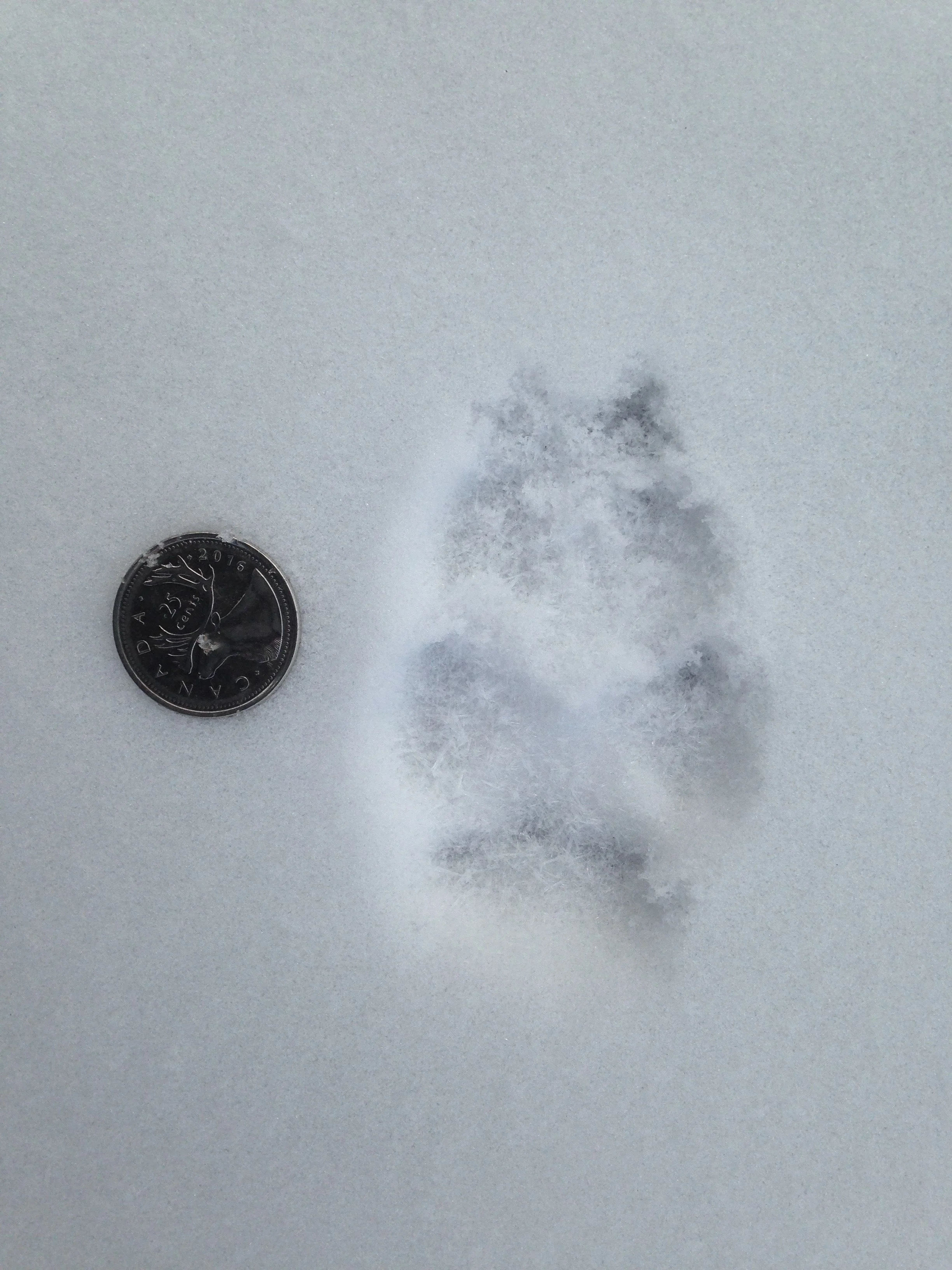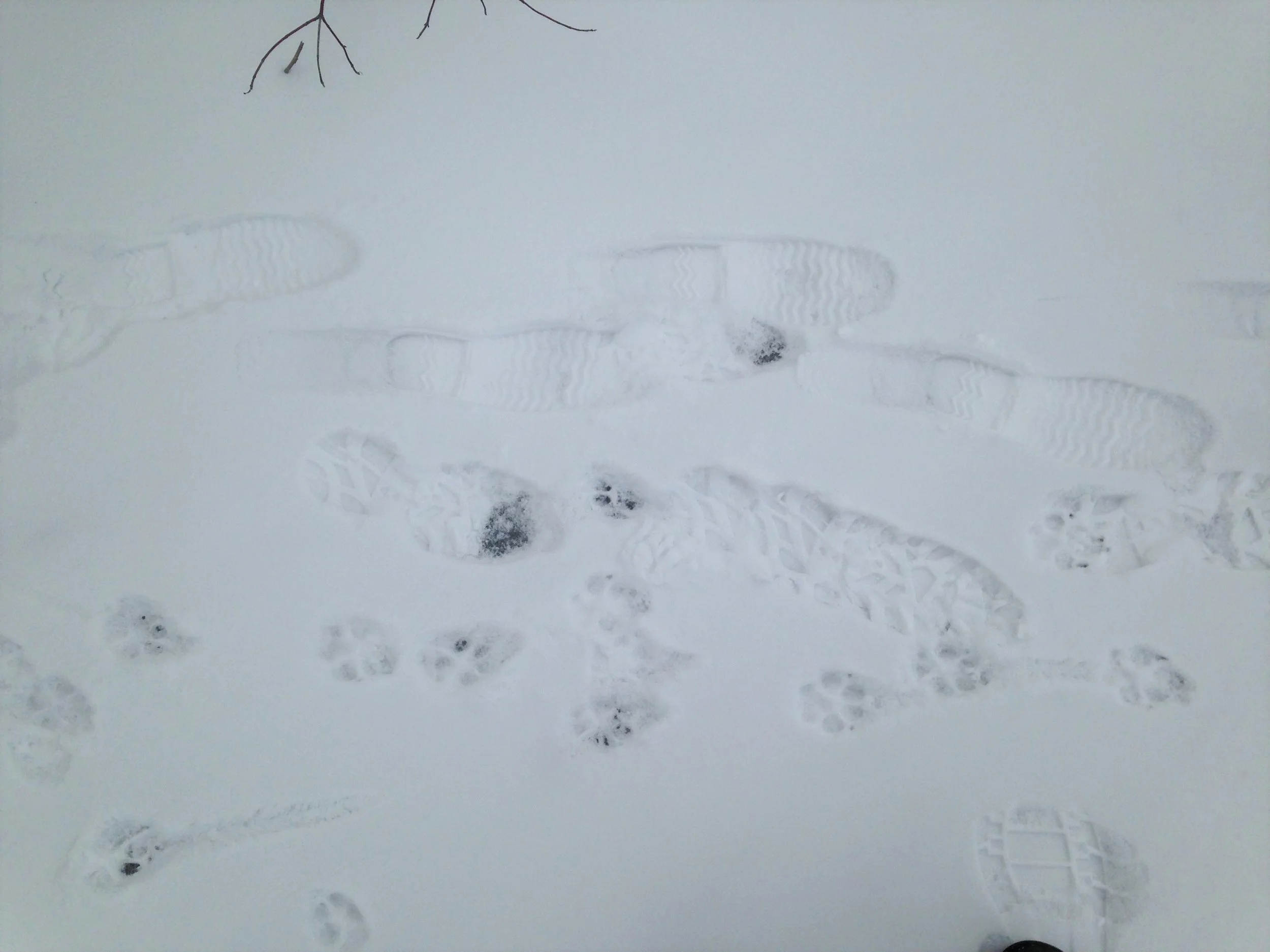In Search of Fisher Tracks, Tracking Journal, 2022.01.11
I was out on the ice real close to where I’d fallen through last year, looking for signs of a possible Fiser (Pekania pennanti) that my friend had said she may have seen a couple of hours before. She had told me about the possible Fisher earlier in the day when were were skating on the frozen river closer to my house. As soon as I was done with the skates, I put on my big boots and went upstream in search of this maybe Mustelid.
It was about -7°C along the river, with a bit of wind (30 kmph) but I didn’t notice too much at first. Sometimes my jacket and sweaters act like armour against the gusts and I only feel it in my hands when the gloves come off and the tape measure comes out. I had walked out to where my friend indicated the tracks would be. 300-400 meters from an abandoned train bridge we use as a landmark when we go on hikes with the folks from work. I was eager to see what I could find. To be honest I wasn’t expecting to find any signs of Fisher, but I was hoping maybe a River Otter (Lontra canadensis) as one had been spotted only a couple of weeks ago a few kilometers up the same river. River Otters and Fishers have very similar tracks as well and it can be hard to tell them apart. River Otters and Fishers are both from the Weasel/Mustelid family along with Minks (Neogale vison), Long-tailed and Short-tailed Weasels (Mustela frenata, and Mustela erminea), and even Wolverines (Gulo gulo), along with a few more. While Wolverines would not be found in my area, there are occasional sightings of River Otters down here. But Fisher? I just don’t know… Once in a while I hear stories from folks saying that their Grandmother saw one while out walking the Dog (Canis lupus familiaris) at midnight in a dark suburb of Guelph, but I just don’t know. There have been sightings as close as 15 km away in Ennotville (2020) and 25 km away at Mountsberg Conservation Area (2018) according to inaturalist.org, but none in Guelph. I admit that along the river there is a corridor of mixed thickety Manitoba Maple (Acer negundo), Staghorn Sumac (Rhus typhina), and Common Buckthorn (Rhamnus cathartica), but this isn’t the type of forest a Fisher requires to hunt in. They prefer more mature coniferous forests, or at least some big mixed woods where they can climb, and possibly even nest in the big dead snags. We don’t have many of those along the rivers edge.
I was out looking anyways, just in case. Who’d want to be too stubborn in their unwillingness to allow for environmental plasticity and shifting ranges to get in the way of possibly finding some really cool tracks so close to home. I went out with an open mind.
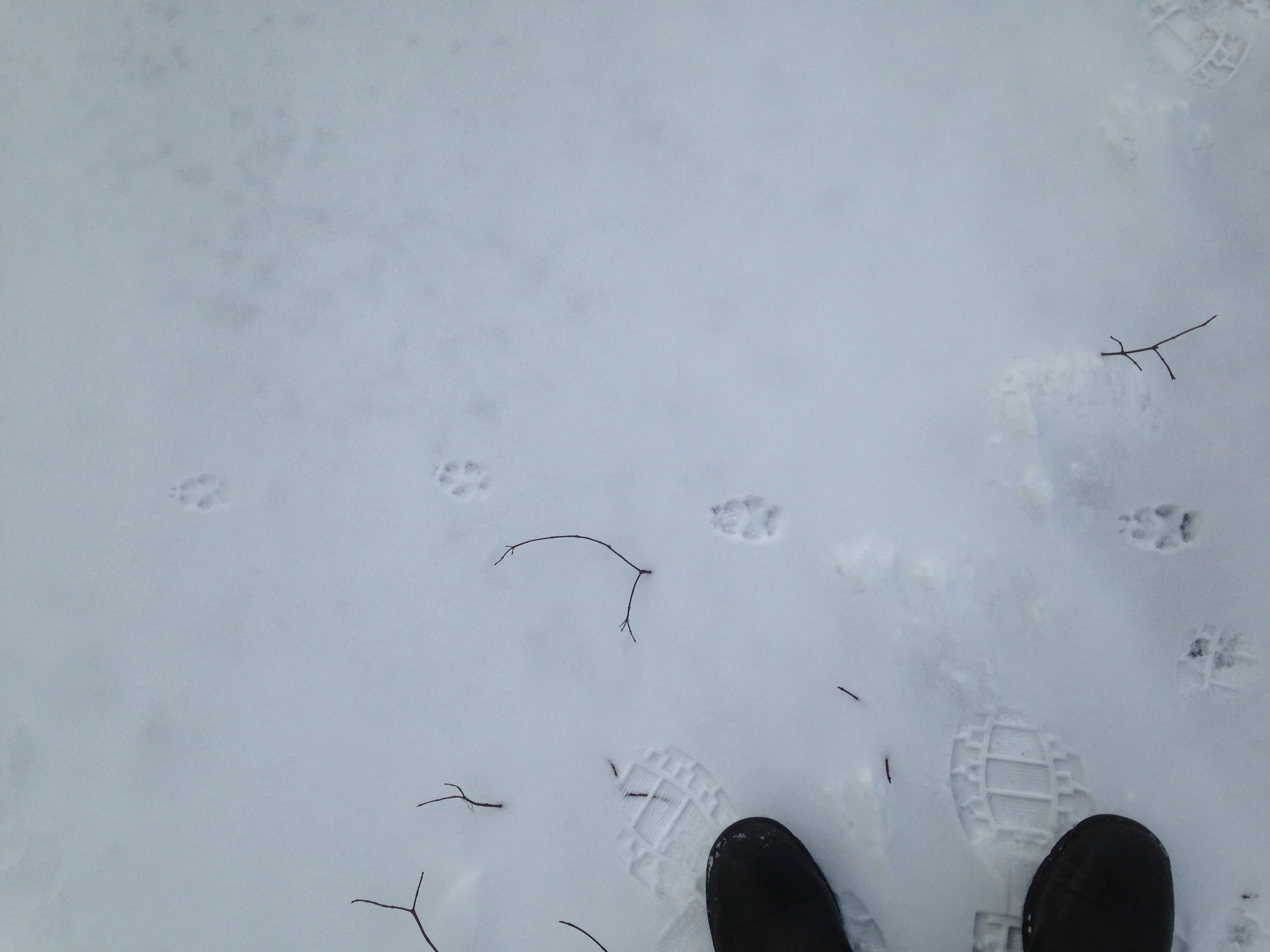
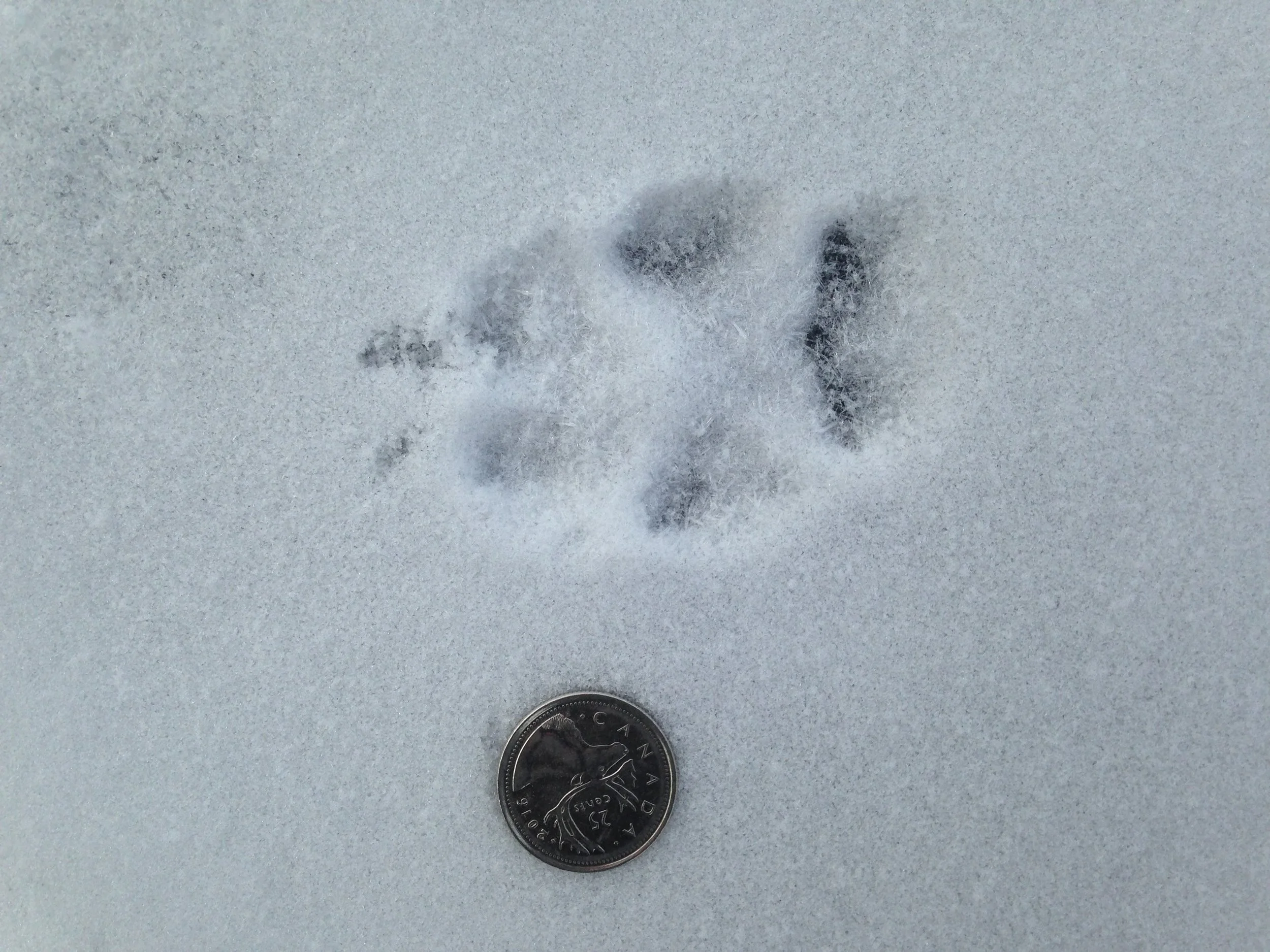
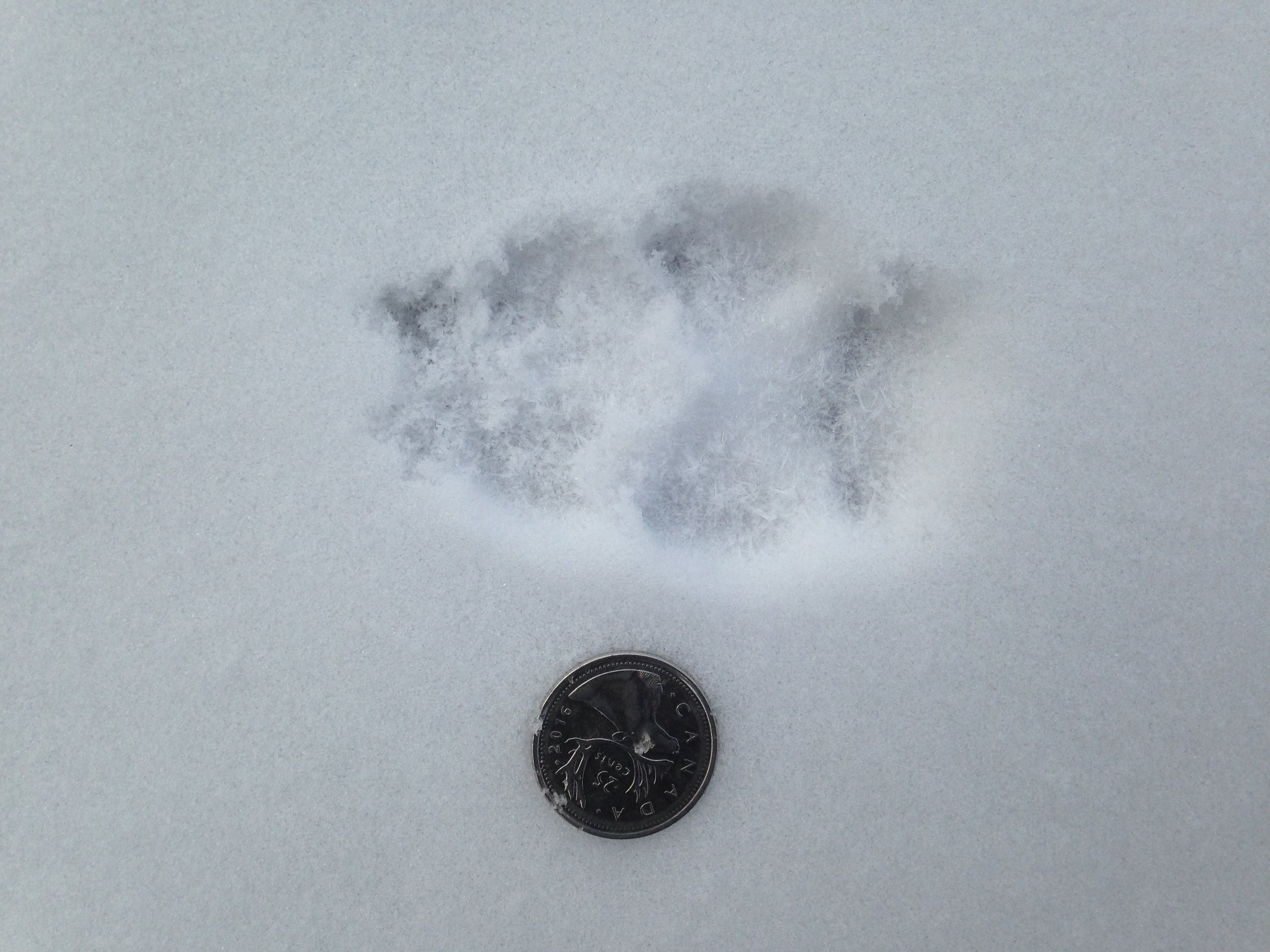
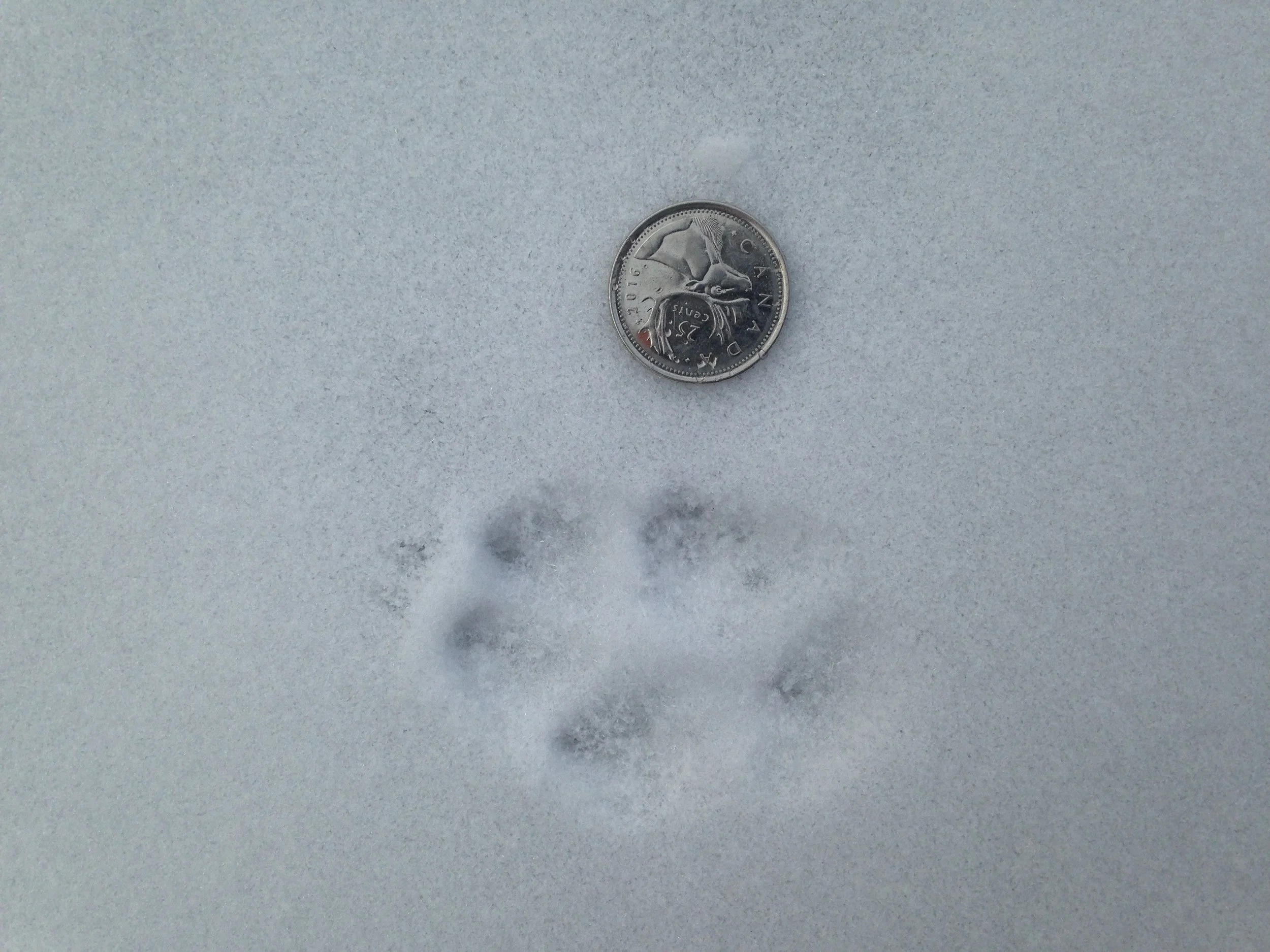

The first trail I picked up on were from a Red Fox (Vulpes vulpes). I watched the gait as I walked, moving from a side trot, to a lope, on to a gallop, back to a lope, back to the side trot, and on and on. They stayed on the river most of the time, only getting off once in a while to explore something I didn’t go to check out, but they always came back. I have been trying to look at the Fox tracks I come across them these past few weeks and I was hoping to measure I find since finding my tape measure again (big gratitude for that!). I found a section of trail that had the repeating pattern of the two fronts, right and then the left, landing and then the two rears, right and left, and then the two fronts again, and then the two rears. This gait is a gallop. It implies that the Fox was moving pretty quickly. The stride length, measured from the heel of the right foot, to the heel of the next right foot in the series of foot falls was 130.5 cm (51 3/8 in), which is on the high end range of measurements of a Fox’s gallop (between 20.3 – 139.7 cm (8 – 55 in). This overlaps with Coyotes (Canis latrans) gallop range which is 30.5 - 228.6 cm (12 - 90 in) so it is was also worth looking for more indicators that this was in fact a Fox and not a Coyote. So I measured the individual tracks as well. In order of how they landed, the tracks measured :
Right front : 6.9 cm L x 4.4 cm W, whereas Coyote would be 6.7 – 8.9 cm (2⅝ - 3½ in) L x 4.1 – 7.3 cm (1⅝ - 2⅞ in) W
Left front : 7 cm L x 4.6 cm W
Right hind : 6.2 cm L x 4 cm W, where as Coyote would be 6 - 8.3 cm (2⅜ - 3¼ in) L x 4.1 - 6 cm (1⅝ - 2⅜ in) W
Left hind : 6 cm L x 3.9 cm W
So aside the the width of the hinds which just fall out of range, all measurements could be on the lowest end of a Coyote. How else do can I tell them apart? A couple of ways.
If you look at this left front track you can see a thin line just above the bottom of the track. This is an exposed hairless ridge of the metacarpal pad and is a pretty key identification feature. I tend to look for this as I walk up to a canid track. This is also a feature which usually only shows on the front feet so it is also helpful in identification of fronts and hinds. Another thing to consider is the greater context of place. I don’t see as many Coyote tracks in that area. It’s not that I never see their tracks, it’s just not as often. I also hear more people telling stories of seeing Foxes around there but rarely am I hearing stories of Coyotes. This is a reminder that it is always helpful to build relationship with places where we are going often, to look around, tell and listen to stories, and ask a lot of questions. Building the relationship and intimacy is a big part of what tracking can and does do. It helps me know who has been moving across the valley, who has been hugging the river, and who is my neighbour. Paying attention to the neighbourhood activities can bring us closer with our neighbours, as long we don’t overstep any boundaries of course… and these particular neighbours might just bite you or piss on your stuff.
The next things I found were my friends tracks.
Sorel boots are popular and I have a pair myself so I know what those treads look like, and I thought I remembered my pal wearing her Sorels before putting her skates on earlier in the day so that would make sense. She had her Dog pal with her so that would be another indicator that it was her. There are another set of slightly larger tracks from a boot brand who’se tread I do not know, but I know that another pal was walking with Sorel and her Dog, and he is slightly taller and I assume has slightly larger feet.
I was glad to come to their trail as I wanted to follow them around and see what they saw in hopes I could find the Fisher tracks which they may have found. It would be a lot easier to just trail them then to follow the directions which I wasn’t entirely positive on. The photo above is from where they stepped onto the river from the shore. So it was the best place to begin.
Sorel has a walking stride length of 105 - 112 cm (~41 - 44 in) with an average of 106 cm (41¾ in). Unknown tread has slightly longer stride length of 117 - 124 cm (46 - 48 in) with an average of 121 cm (47⅝). My hands were getting pretty cold at this point so I didn’t measure the actual boot sizes of either but I did notice that Unknown tread had a wide pitch (the degree to which the foot angles out from the line of travel) which I had not noticed before. I also noticed that he liked to play with the Dog, shuffling to the side and backwards. I could almost see him standing on the ice, knees bent scratching the Dog in a funny voice. I also know he is a sweet guy and probably playful with Dogs.
I followed them for a while as they strolled easily down the ice. They seemed to stop for a couple of things, maybe checking out a tree here, or a track there, but I wasn’t finding any Fisher tracks. I did see some Mink (Neogale vison) trails along the rivers edge ducking in and small caverns in the bank under the grass. I stopped and stooped, looking into the holes and listening for any signs of someone inside. A few years ago I watched a Mink with a Fish in their mouth make their way into a similar hole in the bank of the same river. I got down on the ice that time, and walked up to the hole. I thought I heard something and then was certain I was hearing something. It was the Mink hissing at me. I quicky stepped back, retraced my steps and made my way to shore. This time I wasn’t so lucky. There was no sign, or sound, of any creatures but myself.
I kept following my friends until they made their way back onto the shore. They made their way along a trail until they got to a tree branch which would have been about head height, where it appeared they had stopped for a moment. Maybe they were watching the Dog, maybe they were looking out over the debris from an old encampment nearby. They then turned around and went down another trail which led even further away from the river. I remembered that Sorel had told me the tracks were on the river so I figured that the area where the Fisher should have been was back on the ice where I had been following them, but I didn’t come across any Fisher trail. I got to wondering if it was Mink tracks mistaken for Fisher. Both animals are in the Mustelid family. I decided to walk back a ways and find the largest set of Mink tracks I could find along the trail and then measure them.
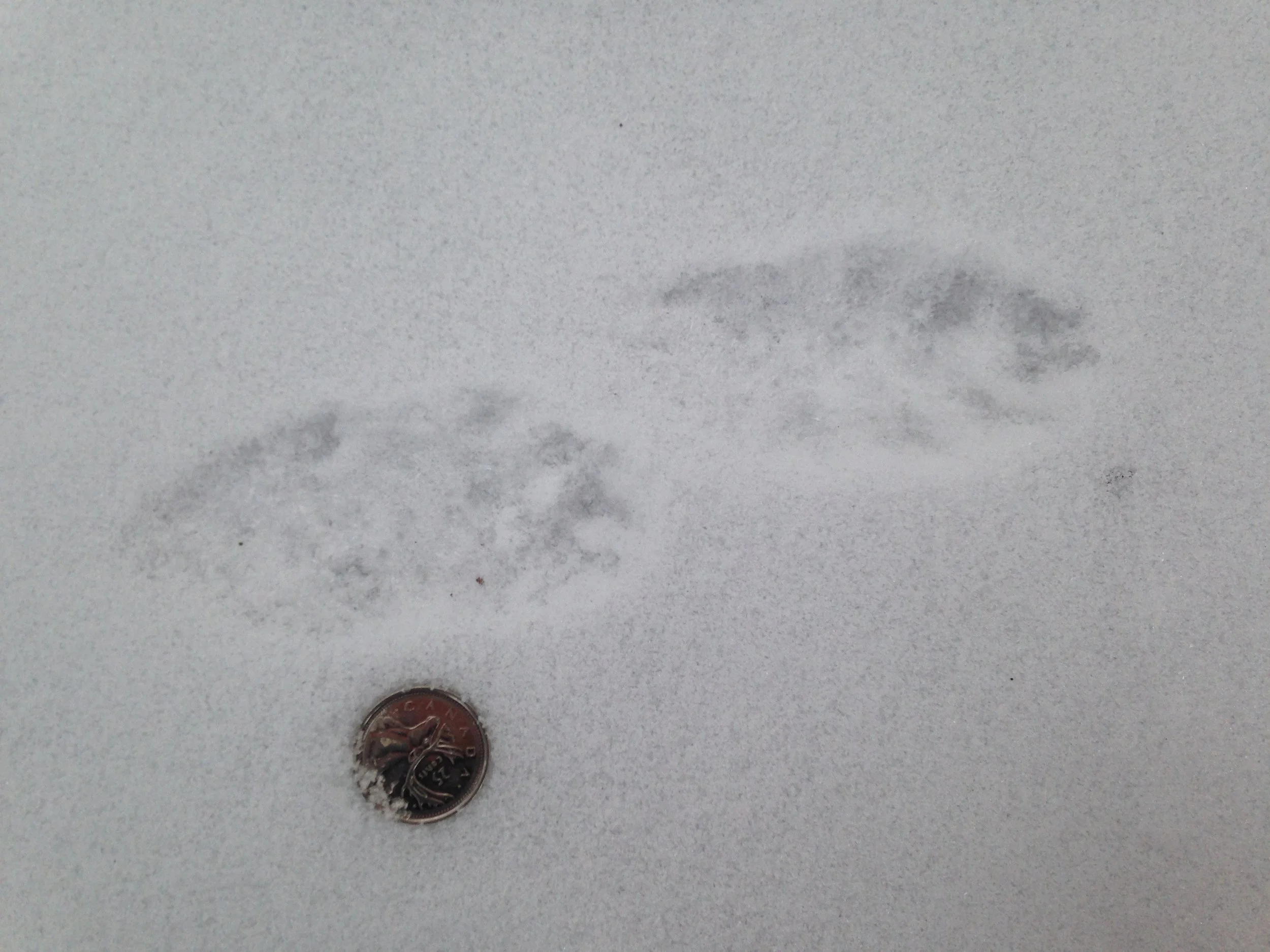
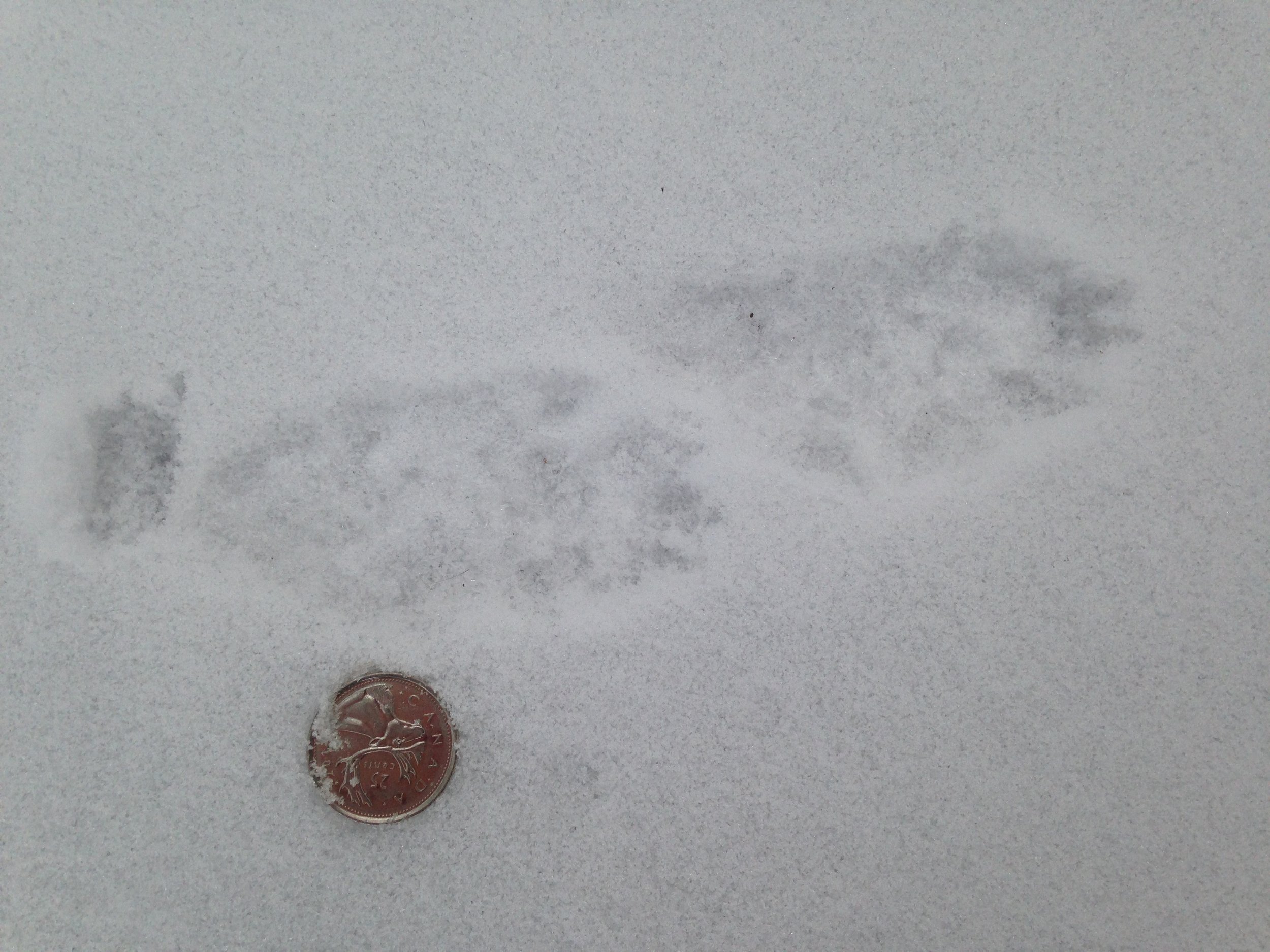
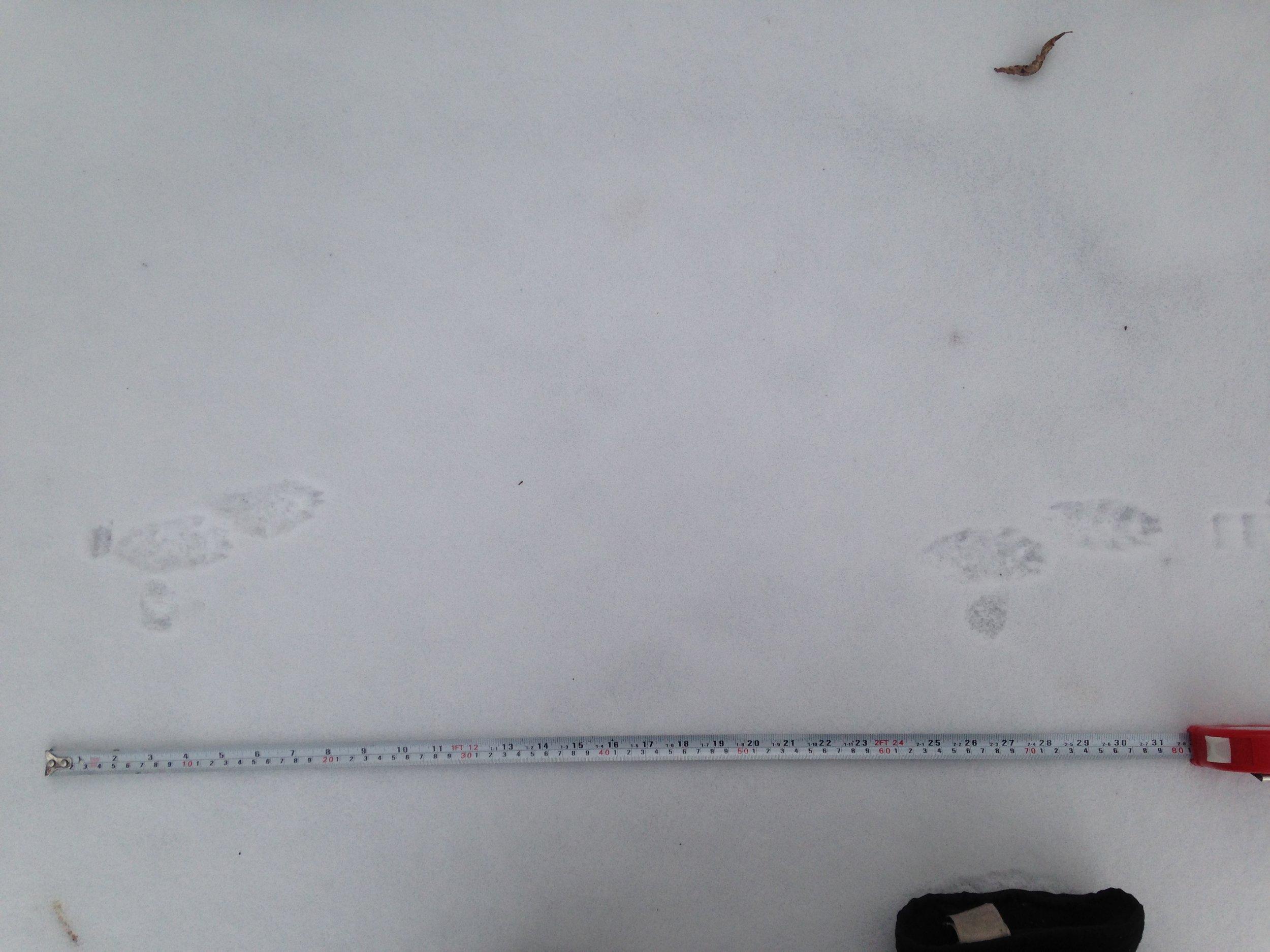
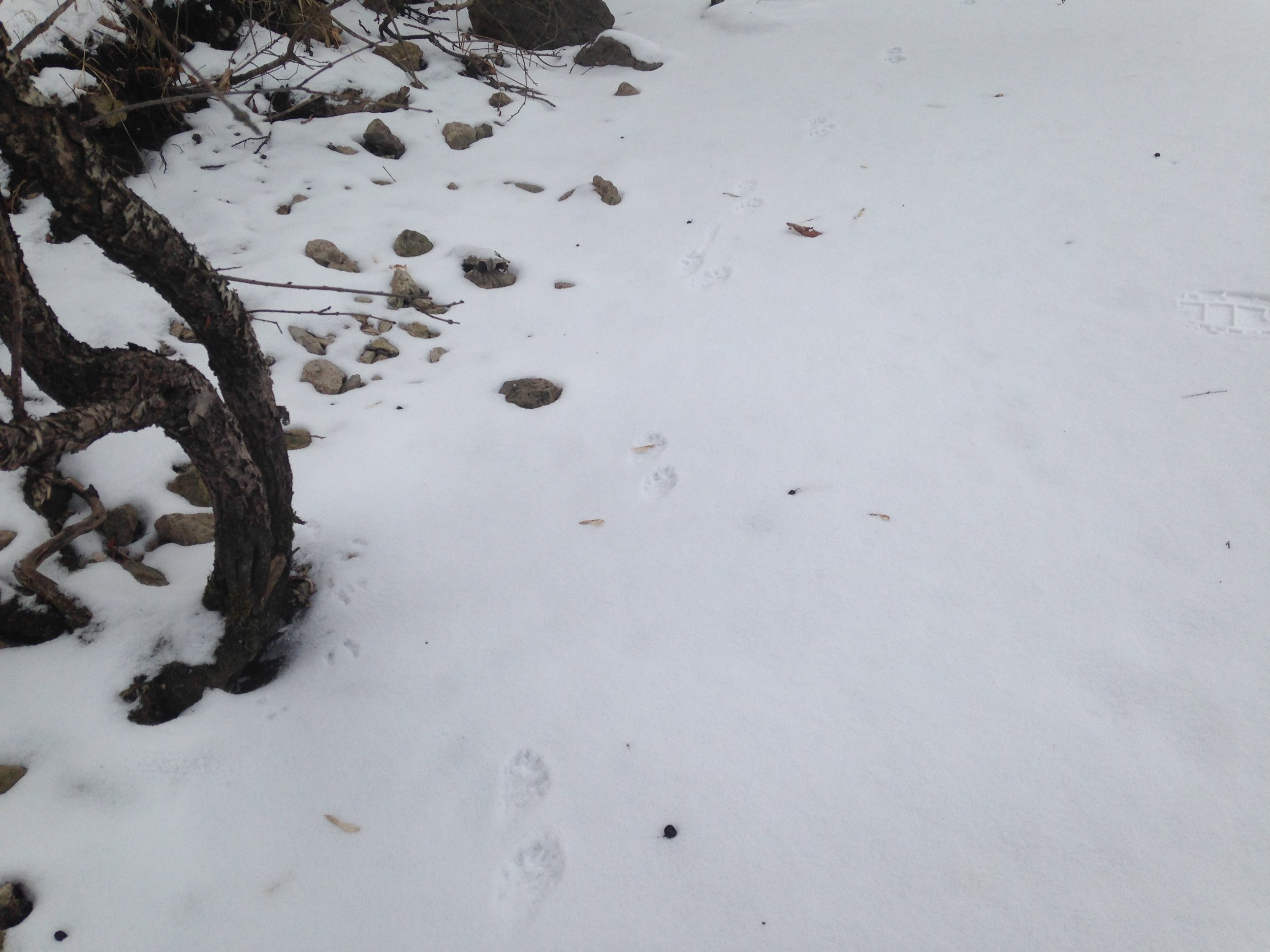
The Mink was moving in a varied gait of a 3x4 lope and 2x2 lope. These are common gaits for Mustelids, and could both be found in a Mink trail or a Fisher trail. A 3x4 lope is when a front and a hind foot on the same side of the body land in the same space, giving the appearance of 3 tracks rather than 4 separate tracks. A 2x2 lope, as pictured above, is similar. It is when two fronts land first, then push off, and the hinds come in and land in the same space that the fronts were just placed previously, giving the appearance of 2 tracks instead of the actual 4 tracks which are present. Here is a video I made (and slowed down for clarity) from a segment of a documentary about Weasels. This Short-tailed Weasel (Mustela erminea) is demonstrating a 2x2 lope.
My hands were getting cold at this point so I only ended up making a couple of measurements which I figured would help differentiate between a Mink and a Fisher. Because the hinds landed on the fronts, it would have been more difficult to measure individual tracks, so I didn’t. I was cold! I could have measured the stride length, but because there is a lot of overlap in stride length measurements across Mustelid species, I decided it was not going to offer any additional evidence one way or the other. The most important measurement I have found when differentiating Mustelids is the trail width. Trail width is pretty simple; it refers to the distance between the outside left tracks and the right tracks. These measurements are taken from the widest point between two tracks. The trail width of this 2x2 lope in the photographs above was 6.9 cm (2¾ in). The trail width on a 2x2 lope for a Fisher would be about 7.6 - 14 cm (3 - 5½ in), so the width from the trail in the photo was thinner, and remember I had sought out the biggest tracks I could find, not the tracks that would be exemplify the norm along this trail.
For the Mink 2x2 lope I was measuring on the river, the group length was 16.7 cm (6 9⁄16 in), and Mark Elbroch and Casey McFarlane in the book “Mammal Tracks and Sign” say that the group length of a 2x2 lope for a Fisher is 15.2 - 33 cm (6 - 13 in) so there is overlap there.
I decided after writing out the measurements in my notebook that I was done for the evening. I was cold bent over this trail on the river with the wind gusting up to 50 kmph). I put my stuff in my backpack, threw my gloves on and walked briskly in the direction of home. I hadn’t expected to see Fisher sign, but it really would have been cool. Even if it wasn’t Fisher, but instead River Otter, that would have been cool. Mink tracks? Yeah that’s still cool. I can easily remember when Minks were novel to me, when I was first getting to know them, first seeing them and their trails. I would walk along the snowy river bank of the Eramosa and just follow the Mink trail with my eyes when it was out of reach, or get down low when they were close enough to inspect. I guess I am grateful again for the possible Fisher to bring me back to measuring the Mink trail once again, to humble myself on the river, bending low to gaze and wonder at the prints left over by the small animals feet. It’s amazing still.

